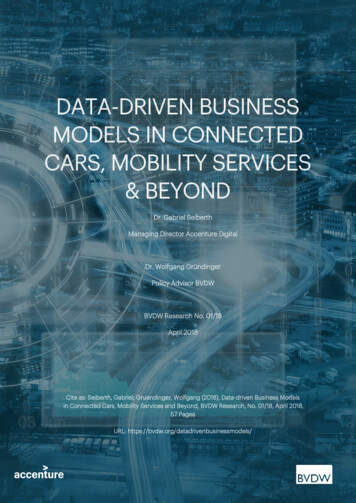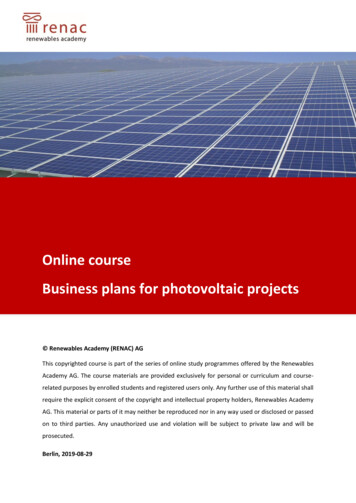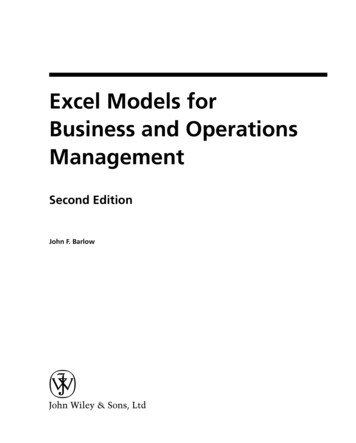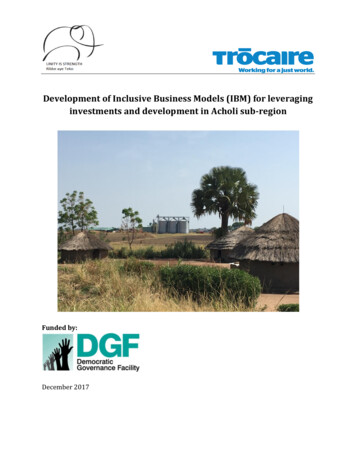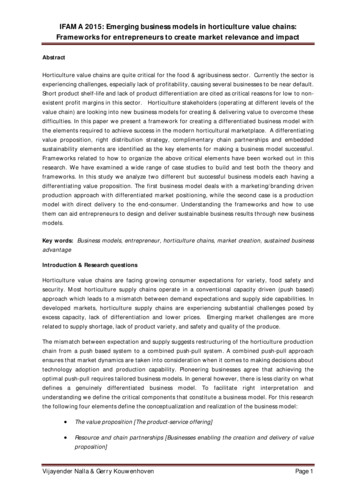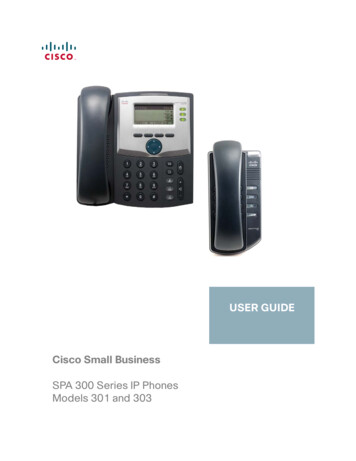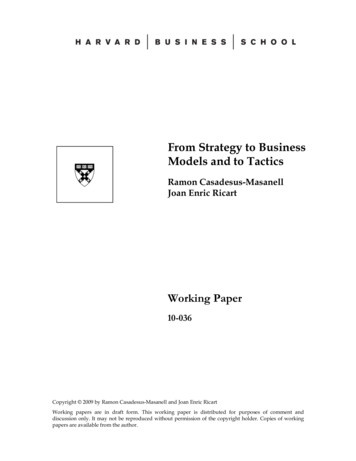
Transcription
From Strategy to BusinessModels and to TacticsRamon Casadesus-MasanellJoan Enric RicartWorking Paper10-036Copyright 2009 by Ramon Casadesus-Masanell and Joan Enric RicartWorking papers are in draft form. This working paper is distributed for purposes of comment anddiscussion only. It may not be reproduced without permission of the copyright holder. Copies of workingpapers are available from the author.
From Strategy to Business Models and to Tactics*Ramon Casadesus-Masanell†Joan Enric Ricart‡November 2009AbstractThe notion of business model has been used by strategy scholars to refer to “the logicof the firm, the way it operates and how it creates value for its stakeholders.” On thesurface, this notion appears to be similar to that of strategy. We present a conceptualframework to separate and relate business model and strategy. Business model, weargue, is a reflection of the firm’s realized strategy. We find that in simplecompetitive situations there is a one-to-one mapping between strategy and businessmodel, which makes it difficult to separate the two notions. We show that theconcepts of strategy and business model differ when there are importantcontingencies upon which a well-designed strategy must be based. Our frameworkalso delivers a clear separation between tactics and strategy. This distinction ispossible because strategy and business model are different constructs.*We thank the Editors and two anonymous Reviewers as well as participants in the Long Range Planningconference on business models held at the Cass Business School in December 2008. We have benefited fromdiscussions with MBA students and executive education program participants at HBS and IESE where we teach asecond-year, case-based elective titled “Competing through Business Models.” Casadesus-Masanell is grateful to theHBS Division of Research and IESE Business School’s Public-Private Sector Research Center. Ricart is grateful tothe Carl Schrøeder Chair at IESE. All errors are only ours.†Associate Professor, Harvard Business School. Morgan Hall 233. Boston, MA 02163, USA. Email:casadesus@gmail.com‡Carl Schrøeder Professor of Strategic Management, IESE Business School. Avenida Pearson, 21. 08034 Barcelona,Spain. Email: ricart@iese.edu
I. IntroductionThe field of Strategy has evolved substantially in the past twenty-five years. Firms have learnedto analyze their competitive environment, define their position, develop competitive andcorporate advantages, and understand threats to sustaining advantage in the face of challengingcompetitive threats. Different approaches including industrial organization, the resource-basedview, dynamic capabilities, and game theory have helped academicians and practitionersunderstand the dynamics of competition and develop recommendations on how firms shoulddefine their competitive and corporate strategies.However, drivers such as globalization, deregulation, or technological change, just to mention afew, are profoundly changing the competitive game. Scholars and practitioners agree that thefastest growing firms in this new environment appear to have taken advantage of these structuralchanges to compete “differently” and innovate in their business models. IBM’s 2006 and 2008“Global CEO Study,” for example, show that top management in a broad range of industries areactively seeking guidance on how to innovate in their business models to improve their ability toboth create and capture value.1Advances in information and communication technologies have driven the recent interest onbusiness model innovation. Many e-businesses constitute new business models. Shafer, Smith,and Linder present twelve recent definitions of business model and find that eight are related toe-business. Of course not all business model innovations are IT-driven; other forces, such asglobalization and deregulation, have also resulted in new business models and fed the interest onthis area.21
New strategies for the bottom of the pyramid in emerging markets have also steered researchersand practitioners towards the systematic study of business models. Academicians working in thisarea agree that for firms to be effective in such unique environments, they need to develop novelbusiness models. In fact, socially motivated enterprises that aim to reach the bottom of thepyramid constitute an important source of business model innovations.3Although it is uncontroversial that for organizations to thrive managers must have a goodunderstanding of how business models work, the academic community has, so far, only offeredearly insights on the issue. In truth, there is not yet agreement on what are the distinctive featuresof superior business models. We believe that the dispute has arisen, in part, because of a lack of aclear distinction between the notions of strategy, business model, and tactics. The purpose of thispaper is to contribute to this literature by presenting an integrative framework to distinguish andrelate the concepts of business model, strategy, and tactics.Put succinctly, business model refers to the logic of the firm, the way it operates and how itcreates value for its stakeholders. Strategy refers to the choice of business model through whichthe firm will compete in the marketplace. Tactics refers to the residual choices open to a firm byvirtue of the business model that it employs.To integrate the concepts of strategy, business model, and tactics, we introduce the generic twostage competitive process framework depicted in Figure 1. In the first stage, firms choose a“logic of value creation and value capture” (choose their business model). In the second stage,firms make tactical choices guided by their goals (in most cases, goals entail some form ofstakeholder value maximization).2
-----------------------------------Insert Figure 1 around here-----------------------------------Figure 1 presents our organizing framework: the object of strategy is the choice of businessmodel, and the business model employed determines the tactics available to the firm to competeagainst, or cooperate with, other firms in the marketplace.The paper is organized as follows. In Section II we define and discuss the notion of businessmodel and present a tool to represent business models. In Section III we study the second stageof the framework. Specifically, we present and discuss the notion of tactics and relate it to thatbusiness model. In Section IV, we move on to discussing the first stage, the strategy stage.Section V revisits the generic two-stage competitive process framework to integrate the threenotions: strategy, business model, and tactics. We discuss the connection between strategy andbusiness model and argue that both notions can be clearly separated. We develop a detailedexample in Section VI. Section VII concludes.II. Business modelDefining business modelThe origins of the expression business model can be traced back to the writings of Peter Drucker,but the notion has gained prominence only in the last decade. While business model has beenpart of the business jargon for a long time, Markides points out that there is no widely accepteddefinition.43
Magretta defines business models as “stories that explain how enterprises work.” This authorgoes back to Peter Drucker and defines “a good business model” as the one that providesanswers to the following two questions: Who is the customer and what does the costumer value?What is the underlying economic logic that explains how we can deliver value to customers at anappropriate cost? Magretta’s implicit idea is that business model refers to the logic by which theorganization earns money. While not formal, Magretta’s approach highlights two fundamentalquestions that any business model should answer, one related to the value provided to thecustomer and the other to the organization’s ability to capture value in the process of servingcustomers.5While Magretta’s definition is broad but imprecise, Amit and Zott’s is less ample (as it focuseson e-businesses) but precise. These authors review the contributions of several theories includingvirtual markets, Schumpeterian innovation, value chain analysis, the resource-based view of thefirm, dynamic capabilities, transaction cost economics, and strategic networks. As they point out,every theory contributes elements to the notion but none, by itself, explains completely thenature of business models. Amit and Zott (2001) analyze a sample of U.S. and European ebusiness models to highlight the drivers of value creation and present the following integrativedefinition: “A business model depicts the content, structure, and governance of transactionsdesigned so as to create value through the exploitation of business opportunities.” Transactioncontent refers to the goods or information being exchanged, as well as to the resources andcapabilities required. Transaction structure refers to the parties that participate, their links, andthe way they choose to operate. Finally, transaction governance refers to the way flows ofinformation, resources, and goods are controlled by the relevant parties, the legal form oforganization, and the incentives to the participants.64
Building on their original definition, Zott and Amit (2010) propose an activity systemperspective for the design of business models. They argue that activity systems capture theessence of business models and propose two sets of aspects that business model designers needto consider: design elements (content, structure, and governance) that describe the architecture ofthe activity system, and design themes (novelty, lock-in, complementarities, and efficiency) thatdescribe the sources of value creation of the activity system.7The common thread across all of these approximations to the notion of business model iscaptured well by Baden-Fuller, MacMillan, Demil, and Lecocq when they define business modelas “the logic of the firm, the way it operates and how it creates value for its stakeholders.” Weadopt their definition as the starting point for our argument.8To make progress, we find it helpful to use the analogy of a machine.9 Any given machine has aparticular logic of operation (the way the different components are assembled and related to oneanother), it runs in a particular way and, in operating, it creates value for whomever uses it. Forconcreteness, consider an automobile. Every automobile has a particular logic of operation. Forexample, conventional automobiles operate quite differently than hybrids, and standardtransmission automobiles operate differently than automatic transmission automobiles. Differentautomobile models create different value for their “stakeholders,” the drivers. Some drivers mayprefer standard transmission. Others may prefer a small car that allows them to easily navigatethe streets of a congested city. Yet others may prefer a large SUV with a powerful explosionengine to enjoy the countryside to the fullest. Different automobiles correspond to differentbusiness models in our analogy. Different automobiles have different particular logics ofoperation and create different value for their drivers.5
Automobiles are made of parts such as wheels, engines, seats, electronics, windshields, and thelike. To create a new automobile and/or to make an assessment of how well a particularautomobile works, one must consider its components and how they relate to one another.Likewise, to better understand business models, one needs to look at their component parts andunderstand how they relate to one another. The question arises: What are business models madeof? We contend that business models are composed of two different sets of elements: (a) theconcrete choices made by management on how the organization must operate, and (b) theconsequences of the choices.Choices include, but are not limited to, compensation practices, procurement contracts, locationof facilities, assets employed, extent of vertical integration, or sales and marketing initiatives.Every choice has some consequence. For example, the provision of high-powered incentives (achoice) has implications regarding the willingness to exert effort or to cooperate with coworkers(consequences). Likewise, pricing policies (choices) have obvious implications regarding salesvolumes, which in turn, affect the economies of scale and bargaining power enjoyed by the firm(two consequences).We distinguish three types of choices: policies, assets, and governance structures. Policies referto courses of action that the firm adopts for all aspects of its operation. Examples of policiesinclude opposing the emergence of unions, locating plants in rural areas, encouraging employeesto fly tourist class, providing high-powered monetary incentives, or flying to secondary airportsas a way to cut expenses. Assets refer to tangible resources such as manufacturing facilities, asatellite system for communicating between offices, or the use of a particular aircraft model byan airline. Governance of assets and policies refers to the structure of contractual arrangements6
that confer decision rights for policies or assets. For example, a given business model maycontain as a choice the use of certain assets such as a fleet of trucks. The firm can own the fleetor lease it from a third party. Transaction cost economics suggests that seemingly innocuousdifferences in the governance of assets and policies may have dramatic effects on theireffectiveness.10In summary, we follow Baden-Fuller, MacMillan, Demil, and Lecocq and define business modelas the logic of the firm, the way it operates and how it creates value for its stakeholders. To makethe notion operational, we argue that business models are composed of choices (policies, assets,and governance) and the consequences derived from the choices.Example: RyanairTo illustrate our notion of business model and introduce a tool to represent business models,consider the famous case of Ryanair. Important choices in its business model include: flying tosecondary airports, lowest ticket prices, low commissions to travel agents, standardized fleet ofBoeing 737s, treating all passengers equally, high-powered incentives, no meals, nothing free,Spartan headquarters, and no unions.11Consequences of these choices are: Secondary airports low airport fees. Lowest ticket prices large volume. Low commissions to travel agents low cost. Standardized fleet of 737s bargaining power with suppliers. All passengers treated equally economies of scale.7
High-powered incentives attracts combative team. No meals faster turnaround. Nothing free additional revenue. Spartan headquarters low fixed cost. No unions flexibility.A useful way to represent business models is by means of a causal loop diagram: choices andconsequences linked by arrows representing causality (based on theories, as discussed above).12Figure 2 is a representation of Ryanair’s business model.-----------------------------------Insert Figure 2 around here-----------------------------------Figure 2 has choices underlined. The non-underlined elements are consequences. Consequencesin boxes are “rigid,” those not in boxes are “flexible.” A consequence is flexible if it is sensitiveto the choices that generate it. For example, “large volume” is a consequence of a policy of lowprices. If the policy changes to high prices, volume is likely to fall rapidly. In contrast, a rigidconsequence is one that does not change rapidly with the choices that generate it. For example, a“reputation for ‘fair’ fares” is a consequence that changes only slowly with the choices thatgenerate it.13Recall the analogy of a business model and a machine. Figure 2 is a representation of how theRyanair “machine” is assembled and how it works. There are many ways in which a machine toperform a given task can be designed and assembled: different levels of redundancy, specificmechanisms, quality of components, et cetera. Different machine configurations have differentdirect consequences affecting the overall level of efficiency of the machine (speed, input8
efficiency, noise, quality of output, and so on). Other airlines are “assembled” differently thanRyanair, they have a different logic, a different way to operate and to create value for theirstakeholders. These different ways to “put together” airlines correspond to different businessmodels.Business models often generate virtuous cycles, feedback loops that strengthen some componentsof the model in every iteration. In the case of Ryanair, examples of virtuous cycles are: Virtuous cycle 1: lowest fares large volume bargaining power with suppliers [lowfixed cost] lowest fares Virtuous cycle 2: lowest fares large volume high aircraft utilization [low fixedcost/passenger] lowest fares Virtuous cycle 3: lowest fares low quality service expected no meals low variablecost lowest fares While virtuous cycles are not part of the definition of a business model, they are crucial in theirevaluation. As the cycles spin, rigid consequences become larger. If those rigid consequences arevaluable, virtuous cycles develop valuable resources and capabilities. For example, as Ryanair’svolume increases (because of its low fares), bargaining power with its suppliers (airportauthorities, Boeing, Airbus.) grows, resulting in improvements in Ryanair’s advantage.14We should point out that the interconnection between elements in a business models is centralalso in Lecocq, Demil, and Warnier (2006). These authors develop a dynamic view of a businessmodel focused on value creation/capture that they refer to as the RCOV Model. Their model hasthree interrelated components: Resources and Competences (RC), internal and externalOrganization (O), and Value propositions (V), connected in a virtuous cycle. The valuepropositions provide the volume and structure of revenues, while the internal and external9
organization provide the volume and structure of cost, thus jointly explaining margins. Theauthors emphasize the permanent interactions between the components of the business models.15Simplifying business model representationsComplete business model representations are often too complex to write down and work with.As a consequence, the analyst is often forced to simplify when representing business models.There are two main ways to simplify to move from the full, true detail of a business model to atractable representation: aggregation and decomposability.Aggregation. Aggregation works by bunching together detailed choices and consequences intolarger constructs. For example, specific incentive contracts (which may be unique to everyindividual in the organization) may be bunched together into a choice called “high-poweredincentives.” This captures the idea that, on average, contracts impose high-powered incentivesonto the workforce. In the business model representation, instead of detailing every possiblecontract that the organization may offer, we simply write: high-powered incentives. This allowsa simplified representation that enhances our understanding.We think of aggregation as “zooming out” and looking at the (real) business model from thedistance. As the analyst zooms out, details blur and larger objects (aggregations of details)become clear. If one keeps his nose close to every choice and consequence, it is impossible tosee the larger picture and understand how the business model works. On the other hand, if onelooks at the business model from very far away, all interesting details are lost. It is more an artthan a science to find the “right distance” from which to assess a given business model. Figure 3shows a highly aggregated representation of Ryanair’s business model.10
-----------------------------------Insert Figure 3 around lity. Sometimes business models are decomposable in the sense that differentgroups of choices and consequences do not interact with one another and thus can be analyzed inisolation. In this case, depending on the question to be addressed, representing just a few parts ofan organization’s business model may be appropriate.DiscussionTwo aspects of our development deserve further discussion. First, note that our approach impliesthat every organization has some business model. This is because every organization makes somechoices and these choices have some consequences. Of course, this does not mean that everybusiness model is satisfactory or even viable in the long run. Other authors define businessmodels normatively, implying that a business model has to consider particular aspects. Forexample, Johnson, Christensen, and Kagermann argue that business models consist of fourelements: a customer value proposition, a profit formula, key resources, and key processes.Likewise, Chesbrough and Rosenbloon, to offer a “detailed and operational definition,” state that“the functions of a business model are to: articulate the value proposition, identify amarket segment, define the structure of the value chain, estimate the cost structure andprofit potential, describe the position of the firm within the value network, and formulatethe competitive strategy.”1611
Following a similar approach, Teece states that “[b]usiness model design involves assessmentswith respect to determining: (1) the identity of market segments to be targeted; (2) the benefit theenterprise will deliver to the customer; (3) the technologies and features that are to be embeddedin the product and service; (4) how the revenue and cost structure of a business is to be‘designed’ (and, if necessary, ‘redesigned’) to meet customer needs; (5) the way in whichtechnologies are to be assembled and offered to the customer; and (6) the mechanisms andmanner by which value is to be captured, and competitive advantage sustained. These issues areall interrelated. They lie at the core of the fundamental question asked by business strategists –which is how does one build a sustainable competitive advantage.”17By defining business model normatively these authors offer valuable guidance on what managersshould be thinking about when designing their business models. At the same time, the normativeapproaches are implicitly imposing bounds on what a complete business model is. Our notion isless demanding. We define business models independently of any features of goodness and/oreffectiveness. We do not consider any a priori categories or variables.Second, according to our conceptualization, an organization’s business model is an objective(real) entity: choices are made in every organization and the choices have consequences. Theparticular set of choices (policies, assets, and governance) made by the organization and theassociated consequences are the organization’s business model because they determine “thelogic of the firm, the way it operates and how it creates value for its stakeholders.” An analystthat studies a particular organization’s business model, however, will generally be unable toprocess the complete business model because it is often too complex (there are too many choicesand consequences). Given this, the analyst proceeds by selecting what he or she believes are the12
key choices (a subset or the complete set of choices). The analyst then observes (or conjectures)the main consequences that are derived from those choices. In connecting consequences tochoices, the analyst is effectively making use of theories (assumptions or beliefs) that provide arationale for the links between choices and consequences. The resulting map of a subset ofchoices and consequences connected by the theories is a business model representation, i.e. theanalyst’s (best) guess of how the actual business model works.18III. TacticsDefining tacticsTactics refers to the residual choices open to a firm by virtue of the business model that itemploys. Consider Metro, the world’s largest newspaper measured by circulation. It is free andad-sponsored and it is published in more than 100 cities in 18 countries. In each city it enters, itcompetes with local newspapers sold at positive prices. Being ad-sponsored, Metro chooses theadvertising rates that it will charge to firms that wish to advertise in Metro. Metro also chooses:the precise number of pages that each edition of the newspaper has, the precise number of ads,the precise balance between news and opinion pieces, and so on. All of these choices are part ofMetro’s tactics. Metro, however, cannot change “price of the newspaper” because its businessmodel is ad-sponsored and the newspaper must be sold at zero price. Put differently, Metro’sbusiness model precludes Metro from using “price of the newspaper” as a variable that can bechanged depending on the intensity of competition and other external factors. Therefore, “priceof the newspaper” is not part of Metro’s set of tactics.19Or consider the case of the competition between Harvard Business School (HBS) and Stanford13
Graduate School of Business for MBA students. In the past few years, Stanford has initiated theoffering of a “tailored MBA:” every student gets a personalized MBA curriculum, depending onhis or her background and professional goals. There is essentially no core curriculum. GivenHBS’s business model, with classes of over 900 students, and sections of more than 90 students,with a strong core curriculum where new teaching materials are developed that end up beingused in many of the school’s executive education programs, with several faculty members coteaching the core courses, and with assets such as classrooms with layouts set up for casediscussions for large groups, it is just impossible for HBS to offer a personalized MBA similar toStanford’s. HBS’s business model does not have as an element in its tactical set the offering of a“tailored MBA.” HBS could modify its business model so that this tactical choice would becomeavailable, but with the current business model it is not possible for HBS to match Stanford onthis dimension. We conclude that different business models give rise to different tactics availablefor competition and/or cooperation.Why are tactics important?Tactics play a crucial role in determining how much value is created and captured by firms. Inthe case of Metro, for example, advertising rates and the precise number of ads displayed in thefree newspaper end up affecting the readership and advertising revenues. Indeed, as more andmore ads are included in Metro, readers become increasingly irritated and less willing to read thenewspaper. Likewise, as the advertising rate increases, fewer advertisers will want to advertise inMetro and this will affect Metro’s revenues, profit, and value capture. Therefore, not only thebusiness model employed by the firm determines tactics but also tactics play a central role inhow much value the firm will be able to create and capture at the end of the day.14
To illustrate this point, let’s bring back the analogy between business models and automobilesintroduced above. In that analogy the automobile was the business model. Of course, the way theautomobile is built places constraints on what the driver can do (it determines the action set fortactics). For example, a large, powerful SUV makes it hard for a driver to maneuver on thenarrow streets of Barcelona’s Gothic Quarter. A small, powerless compact car would make thistask far less cumbersome and would create more value for the driver. As a matter of fact, thereare tactics that are possible with the compact car (such as driving through a really narrow street)that would be impossible (not in the action set) with the large SUV (just as in the example ofHBS and Stanford GSB). The SUV would create little value for the driver in this case. The shapeof the automobile (an element on how the machine is built – its business model), placesconstraints to what the driver can do.Tactical interactionWe answered the question “why are tactics important?” by arguing that, at the end of the day,tactical choices determine how much value is created and captured by the firm. But there is moreto tactics than the effect that they have on value creation and value capture to the firm employingthem. In reality, tactical choices also affect value creation and value capture of other firms withwhich the focal firm interacts. Tactical interaction refers to the way organizations affect eachother by acting within the bounds set by their business models.Using the imagery of business model representations, tactical interactions occur when one firm’sbusiness model is in contact with that of another firm.When this happens, there areconsequences in both firms business models where feedback to the rest of the system isdetermined not only by the focal firm’s choices, but by the choices of the other firm as well.15
To illustrate this point, consider the following example. When a discount retailer competes withthe local mom-and-pop store, both firms engage in a tactical pricing battle to win customers. Theinteraction between the discounter and the mom-and-pop is captured in Figure 4, which displaysboth business models connected at market share.-----------------------------------Insert Figure 4 around here-----------------------------------As the diagram shows, the discount retailer’s prices affect value capture for both the discounterand the mom-and-pop, and vice versa.20The business model employed by a firm determines the tactics available to the firm to competeagainst, or to cooperate with, other firms in the marketplace. Therefore, business model andtactics are intimately related. In the example of the discount retailer and the mom-and-pop,while both firms use prices in their tactical interaction, the discount retailer brings superiorweapons to the fight because of the business model that it employs to compete. Specifically, therange of prices it can profitably set is much broader than that of a competitor laden with a h
relate the concepts of business model, strategy, and tactics. Put succinctly, business model refers to the logic of the firm, the way it operates and how it creates value for its stakeholders. Strategy refers to the choice of business model through which the firm will compete in the marketpl



